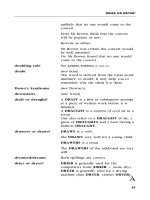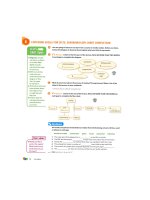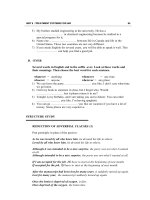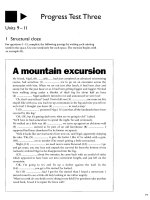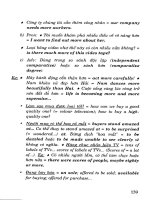SAT practise test 20000 part 8 potx
Bạn đang xem bản rút gọn của tài liệu. Xem và tải ngay bản đầy đủ của tài liệu tại đây (73.27 KB, 8 trang )
18. A Unpack the tangle of terms, and you’ll find the answer. You are looking
for two prime numbers that:
1. When you subtract them you get 21.
2. When you multiply them you get one of the answer choices.
It might not sound like enough information to find the answer, but it is.
None of the answer choices are very great, so one or both of the prime
numbers must be less than ten. If the two primes were greater, their
product would not be as small as the answer choices. The difference
between the two primes is 21, which means that one of the prime
numbers must be small. Good candidates for the lesser prime are 2, 3,
or 5.
Prime numbers starting in the 20s are 23, 29, 31, and 37. Use a little
trial and error, and you’ll realize that the difference between 23 and 2 is
21. Those are the two primes. What is 2 times 23? The answer is 46,
choice (A).
19. B First, it always helps to draw a quick sketch of the scenario to get a
better grasp on what is being asked.
The first thing to determine is the midpoint of DE, which you can do by
using the midpoint formula:
S
x
1
1 x
2
2
,
y
1
1 y
2
2
D
5
S
0 1 5
2
,
12 1 0
2
D
5
S
5
2
,
12
2
D
5
~
2.5,6
!
You can keep the x-value as a fraction if you like, but converting it to
2.5 will make it easier to punch into your calculator.
57Copyright © 2005 Thomson Peterson’s, a part of The Thomson Corporaton
SAT is a registered trademark of the College Entrance Examination Board, which
was not involved in the production of and does not endorse this product.
Looking at the dashed lines, you can see a right triangle with its
hypotenuse from the origin to the midpoint of DE. It has sides of 2.5
and 6. Placing those values into the Pythagorean theorem yields:
a
2
1 b
2
5 c
2
2.5
2
1 6
2
5 c
2
6.25 1 36 5 c
2
42.25 5 c
2
=
42.25 5
=
c
6.5 5 c
It’s choice (B).
20. A It’s a big equation, but in the end it’s just that: an equation. You have to
pull out two different techniques—FOIL and PEMDAS—to solve it,
but so long as you write out your work carefully, you will reach the
right answer.
2b
2
5
~
b 2 7
!~
b 1 3
!
2
~
2b 1 2
!~
b 1 5
!
2b
2
5
~
b
2
1 3b 2 7b 2 21
!
2
~
2b
2
1 10b 1 2b 1 10
!
2b
2
5
~
b
2
2 4b 2 21
!
2
~
2b
2
1 12b 1 10
!
2b
2
5 b
2
2 4b 2 21 2 2b
2
2 12b 2 10
2b
2
52b
2
2 16b 2 31
2b
2
1 b
2
52b
2
1 b
2
2 16b 2 31
0 5216b 2 31
0 1 16b 5216b 1 16b 2 31
16b 5231
16b
16
5
231
16
b 52
31
16
521
15
16
Choice (A) is your answer.
21. A There’s no table given for this question, so it’s up to you to create one.
In this respect it’s like a diagram without a diagram given: You could
conceivably answer it without the visual aids, but it’s much easier
with them.
For the table, start with the years:
1950 1960 1970 1980 1990 2000
58 Copyright © 2005 Thomson Peterson’s, a part of The Thomson Corporaton
SAT is a registered trademark of the College Entrance Examination Board, which
was not involved in the production of and does not endorse this product.
Now place the number of people in Cree County in 1950 in the
appropriate place, and then start multiplying by three.
1950 1960 1970 1980 1990 2000
1000 3000 9000 27000
In the 1980s, the population fell by one-half, so divide 27,000 by 2.
Then go back to multiplying by 3.
1950 1960 1970 1980 1990 2000
1000 3000 9000 27000 13,500 40,500
Your answer is choice (A).
Section 3
1. A Something that can be counted requires “fewer” rather than “less.” The
answer is (A).
2. B In for Ada and I, I is used here as the object of a preposition (for). That
should never be. Me is the object of a preposition, or a direct or indirect
object. The answer is (B).
3. B Is the subject in this sentence singular or plural? Team is singular. Is the
verb singular or plural? Compete is plural. The clause which is
comprised of four cyclists obscures the subject-verb disagreement, but
it is still there. (B) is the answer.
4. E Did you hear any mistakes in this sentence? Hopefully you didn’t
because there are not any. (E) is the answer.
5. A If you know that Louis and Clark were nineteenth-century explorers,
the verb have surveyed might sound strange even before you read the
rest of the sentence. If not, were well prepared suggests that the first
exploration happened prior to an event which is, itself, in the past. The
first verb should be had surveyed, and the answer is (A).
6. D There is a parallel structure problem here. Focus, a verb, should be
paired with follow up, a verb, not follow-up, which is a noun. The
answer is (D).
7. C Nothing in this sentence sounds wrong, but (E) is not the answer. Here’s
why, to whom does the its refer? It is not clear if it refers to the Ottoman
or Austrian Empire. An ambiguous pronoun reference is an error, and
so (C) is the answer.
59Copyright © 2005 Thomson Peterson’s, a part of The Thomson Corporaton
SAT is a registered trademark of the College Entrance Examination Board, which
was not involved in the production of and does not endorse this product.
8. A What is the subject, census (singular) or statistics (plural)? Statistics.
Census is used as an adjective. The plural subject means you would
need a plural verb, were. The answer is (A).
9. B Scarcely no one is a double negative. It should be scarcely anyone. (B) is
the answer.
10. D This is a tricky question because the error arises with the implied part of
the sentence. The full sentence with the implied part written out
explicitly reads, “Even though he had the title of Vice-President of
Operations, his duties and responsibilities were not much greater than a
midlevel manager’s duties and responsibilities.” The short version
should still say manager’s. The answer is (D).
11. D After both, you especially need parallel structure. It should read more
accessible and more understandable. The other answers only confuse
the original. The answer is (D).
12. D The initial modifier should put you on the lookout for an incorrect
noun, or reference to the “thing” that is being modified. You should
examine the noun that directly follows the modifier carefully. Does the
modifier modify the noun that follows it? Nope. The poet, Gerard
Manley Hopkins, not his poems, is what is being modified here. The
possessive form (Hopkins’s) and the noun poems messes things up in
the original and answer choices (A), (B), and (C). To make it work, you
need to get rid of the possessive on the author’s name. Only (D) and (E)
do that. (E) makes an unnecessary change to the verb. The better
answer is (D).
13. E The original underlined phrase is not glaringly obtuse or a grammatical
disaster, but it is a little wordy. Also, this includes the Human Rights
Commission is a complete sentence, so it would need to be attached
with a semicolon. Only (E) addresses both problems without creating
others.
14. C The most blatant mistake here is that, again, the clause that follows a
comma is technically a complete sentence. The best way to approach
this question is to read all the way through each of the answers to see if
they contain problems. (B) has tense problems. (D) also has two
complete sentences attached by a comma (this is called a comma splice).
(E) just doesn’t work. The answer is (C).
60 Copyright © 2005 Thomson Peterson’s, a part of The Thomson Corporaton
SAT is a registered trademark of the College Entrance Examination Board, which
was not involved in the production of and does not endorse this product.
15. B The underlined portion of the sentence reads awkwardly for two
reasons. First, it includes the phrase her plans of, which is redundant
because the list is a list of her plans. Second, the preceding plans in the
list are given in infinitive form (i.e. to refinance), but the last plan of
action is not in infinitive form. Any answer choice that deals with these
two issues will be the best choice. (B) is that answer choice.
16. B You know the correct answer won’t be a complete sentence, because it
is attached by a comma to the main clause. Eliminate (E). You will also
want to cut down on wordiness, rather than add to it. Eliminate (A) and
(C). Which suggests that the clause modifies a noun that comes just
before it. That isn’t the case. The answer is (B).
17. C Again, you want to move toward parallel structure as much as possible.
You don’t want nouns in one part of the list and verbs in another, as you
have now. Change the noun tolerance to a verb, tolerate. You can
narrow the field to (C) and (E). (E) is wrong because you don’t use a
comma in a two-items list.
18. D Guess what? Parallel structure again. To commit a crime needs to be
followed by (to) conceal it. That leaves (D), without you even having to
know that among suggests more than two people, whereas between
suggests two.
19. C Here’s the test writers’ other favorite trick: “not only” with “but also.”
Only (C) and (E) use this construction. (E) makes the tenses
unnecessarily complex. The answer is (C).
20. D The sentence as it stands is muddy and unnecessarily wordy. These are
things to be avoided in good writing. “If” should be followed by a
“then” clause. What follows here doesn’t fit that logical pattern. So if is
out. That leaves (D) and (E). (D) gets rid of the repetitive and vague it in
the second part of the sentence. Good. The answer is (D).
21. D The original version should wave a red flag at you that it is repetitive
and cumbersome and will need to be changed. (B) is even more vague
and wordy than the original, despite being a single sentence. (C) is weak
because it begins the essay with the word it, which is never a strong
opener. (E) is suspect because the essay is about the word modern not
modernity. (Yes, modernity is later introduced, but that does not
change the point that the essay is about the word modern.) (E) is also
unnecessarily wordy. That leaves (D).
61Copyright © 2005 Thomson Peterson’s, a part of The Thomson Corporaton
SAT is a registered trademark of the College Entrance Examination Board, which
was not involved in the production of and does not endorse this product.
22. B Descartes is the thing that will link the two sentences. He is the subject
of the first and the object of the second. This is a prime example of
when to use whom. (B) is better than (C) and the others are longer than
the original, not shorter. (B) is the answer.
23. E What is the logical connection between the opinions of academics other
than philosophers and the opinions of historians in particular? The
latter is an example of the former. The answer is (E).
24. B The original sentence is clunky because it has both beginning of
modernity and beginning of modern times. You will want to replace the
second with it. That leaves (B) and possibly (E). (E) adds unhelpful
extra verbiage in other places, so (B) is the best answer.
25. E Anything separated by commas should be detachable from the rest of
the sentence. Remove the phrase between commas and you get Most of
us wearethinking. Bad. Most of us think. (E) is the only answer that
addresses that problem correctly. (B) actually changes the sense by
eliminating the subject of “think” so that it becomes a command.
26. B Choices (C) and (E) have an imprecise and unclear 2ing verb, so
eliminate them. (D) is just a wordier alternative to (B), so eliminate it.
(B) is so straightforward and clear that it is better than the original. The
answer is (B).
27. E The passage is talking about the 1920s. Be as specific as possible,
without being wordy as in (C) and (D). The answer is (E).
28. C The only punctuation marks that are possible here are parentheses, a
semicolon or a colon. The second sentence gives more specific
information to elaborate on the first sentence, so a colon is better than
a semicolon or parentheses. The answer is (C).
29. D What’s wrong with the transition in the original? Is it a logical problem
or a grammatical problem? It sounds weird and wordy, so it’s a
grammatical problem. The sense is logical, so keep it. Eliminate (A); it
changes the sense. Which of the answers simplifies and clarifies the
grammar? The answer is (D).
30. A Eliminate (D) because it’s grammatically incorrect. Eliminate (C)
because it really doesn’t go with the ideas in the passage. If you look
back at the passage, you’ll see that the last sentence is not about Macy’s
but Bloomingdales. (E) would be out of place, so eliminate it. You’re
left with (A) and (B). While (B) would be an adequate conclusion to the
third paragraph, only (A) reflects back over the entire passage. The best
answer is (A).
62 Copyright © 2005 Thomson Peterson’s, a part of The Thomson Corporaton
SAT is a registered trademark of the College Entrance Examination Board, which
was not involved in the production of and does not endorse this product.
Section 4
1. D Jerome does not indulge much. He is an ascetic, (D). A teetotaler, (B), is
someone who does not consume alcohol. A gourmand, (C), is someone
who indulges a great deal in fine food. Neither (A) nor (E) have
anything to do with indulgence.
2. A Begin with the first blank, since you know that it must be something
negative since protests were planned. (B) and (D) are not negative, so
eliminate them. Going to the second blank, organized fits well, while
negotiated and theorized do not (you don’t theorize about a protest
event). This makes (A) the best answer.
3. B We know the first word will be negative, since it engendered criticism.
All of the words are negative, so you can’t eliminate anything yet. But
what would a politician be if he “seized a ceremony” having to do with
a “girl’s tragic death to speak out against his opponent”? Not militaris-
tic, or unreceptive, certainly not passive or defeatist. The answer is (B).
4. E All of the options in this question have a first word that could be
something one software did to another. For the second word, all the
choices, except (D), are things a user could likely do to software.
Preclude, (A), means make something impossible, but the “prior
version” clearly isn’t impossible so eliminate (A). If the older version is
outdone, you don’t want to implement, or use, it. Eliminate (B). If
something is infected, you don’t want to disregard it, so eliminate (C).
The answer is (E). Supercede means replace by being better, which
would mean you could throw out, or discard, the now useless thing.
5. B Let’s start with the first blank since it has to be paired with long. Which
of the first answer choices pairs well with long? Only storied,
exemplary, and reputable do (the others either are awkward or don’t fit
with the meaning of the sentence). Plug in the second answer choices of
(A), (B), and (E) into the sentence. Can poetry initiate the dignity of
humanity? No. Eliminate (A). Can it articulate, or express? Definitely.
Choice (B) sounds too good to pass up.
6. C You should have a good sense of what kind of word goes in each blank
because each blank has a pair. The second blank has a more obvious
pair, so start with it. Which of the second answer choices goes with
speedy? (A) and (C) are the best candidates. On the first blank, does
intricate and laborious or fragile and laborious sound better? Intricate
does because it provides a better contrast with the second half of the
sentence. (Also, it is strange to speak of a surgery being fragile; someone
in surgery might be in fragile health, but the surgery itself would not be
fragile.) (C) is the answer.
63Copyright © 2005 Thomson Peterson’s, a part of The Thomson Corporaton
SAT is a registered trademark of the College Entrance Examination Board, which
was not involved in the production of and does not endorse this product.
7. A Despite at the beginning of the sentence is the main clue to unlocking
the blank. You need one positive word and one negative word.
Eliminate (B) and (C). Now what can clans do to each other? Assist,
possibly discount. A problem is ameliorated, not a person or group of
people. (A) is the better answer, especially since “feud” and “clan” are
both words that seem to refer to the past.
8. B From the structure of the sentence, we can see that the word in the
blank goes along with humor and merriment. Which of the answer
choices fits with these two positive words? Only (B), mirth, does.
(Irony, history, and mystery, are at best neutral terms in this context,
not positive.)
9. A The Latin makes this sentence complicated. You can combat this by
replacing the Latin words with the letters (A) and (B) in your head (i.e.
although (A) has more subspecies than (B) ).Thealthough is the key
to the logic of the sentence structure. Although (A) has more subspecies
than (B), (B) has greater numbers. (A) and (E) match this pre-guess for
the first blank. (E) isn’t really logical (how can a region be ominous?),
so the answer is (A).
10. D Looking at the first blank, (B) and (E) can be eliminated because both
are not conventional English. That leaves (A), (C), and (D). (A) is
suspect, though, because progression is an odd word choice for the
context. (C) is illogical. (D) is a best choice because it flows well in both
blanks and because development is already a word you associate with
“pregnancy” and “fetus.”
11. C The word, Though, tells you that the ideals and the practices of the
organization are at odds. So if the ideals are outward-focused then the
practice must be inward-focused. Which of the answer choices matches
this pre-guess? Only (C), insular (isolated, circumscribed), does.
Hermetic means tightly sealed. It’s not too far off in meaning, but it
doesn’t refer to group behavior.
12. B On the first blank we know that the word goes with base, and we know
that the prosecuting attorney is probably not saying nice things about
the defendant. (A) and (B) fit this (motley doesn’t; even though it has a
negative connotation, it means a random or ungainly assortment). This
leaves misunderstanding the testimonials or misconstruing the testimo-
nials, for the second blank. The latter is a better choice since the
prosecuting attorney is more likely to be making the defendant sound
bad on purpose than by mistake.
64 Copyright © 2005 Thomson Peterson’s, a part of The Thomson Corporaton
SAT is a registered trademark of the College Entrance Examination Board, which
was not involved in the production of and does not endorse this product.




